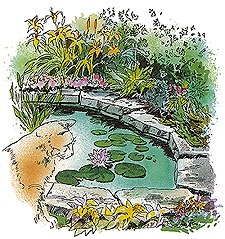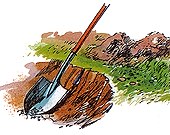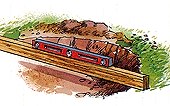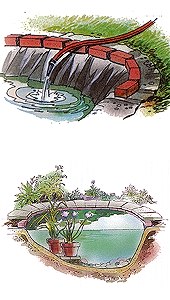





 Make sure your garden pondis at least 2 to 3 feet deep.
Make sure your garden pondis at least 2 to 3 feet deep.
For an appealing home for goldfish and aquatic plants, and an attractive feature of your yard, nothing beats a garden pond. It can be surprisingly easy to install and maintain if designed carefully. By excavating a hole, packing it with a layer of sand, and lining it with polyvinyl chloride (PVC) sheeting, you can create a pool of any shape you choose.
Before you start: Your pond should be sited on level ground, in an area that gets at least five hours of sunlight, is accessible to a garden hose, and is located where you can enjoy the view from your house, deck, or patio. Surprisingly, bigger is better for a backyard garden pool. Anything less than 2 feet deep and 8 feet in diameter collects heat and clogs with algae. In cold climates, dig an area at least 3 feet deep in which your creatures can live through the winter.
Check before you dig. A quick call to your town's building department can help you locate water, gas, and electric utility lines. Lay out your pond by arranging a garden hose to mark the shape you want. Dust the hose with sand or flour to make a guideline for digging.
continue reading below Step 1
Step 1
1. Dig the hole a minimum of 24 inches deep, sloping the sides slightly. Completely remove any large roots or sharp stones.
 Step 2
Step 2
2. Use a level on top of a straight 2x4 to make sure that the pool rim is even. Pack the bottom and sides of the hole with 2 to 3 inches of moist sand. This helps smooth the sides and protect the liner from being punctured.
3. Position the PVC liner in the hole, leaving an extra 12 inches of liner all the way around the pond. Edge the pond with brick and trim the liner so the coping will hide it.
 Steps 3, 4, and 5
Steps 3, 4, and 5
4. Create a base for the stone coping with a bed of gravel. Lay the coping in place so it extends 1 to 2 inches beyond the brick border. Let the water stand for two days to disperse any treatment chemicals, then position pots of water plants, using stacked bricks to raise them to the proper height.
5. Set the aquatic plants at the depth each requires. For example, water lilies should be set so the rim of the pot is 6 to 12 inches beneath the surface of the water. Gently set round stones on the bottom of the pond. When choosing aquatic creatures such as fish, snails, and tadpoles, check with your supplier about how many cubic feet of pond surface they need.
Copyright © www.100flowers.win Botanic Garden All Rights Reserved